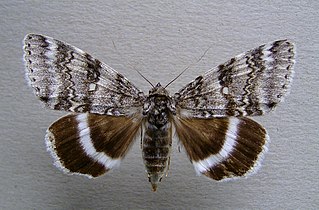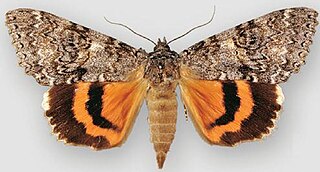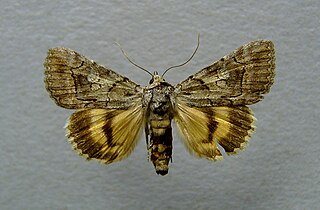
Catocala is a generally Holarctic genus of moths in the family Erebidae. The genus was erected by Franz von Paula Schrank in 1802. The moths are commonly known as underwing moths or simply underwings. These terms are sometimes used for a few related moths, but usually – especially when used in plural, not as part of a species name – they are used to refer to Catocala only.

Olepa schleini is a moth of the family Erebidae first described by Thomas J. Witt, Günter C. Müller, Vasiliy D. Kravchenko, Michael A. Miller, Axel Hausmann and Wolfgang Speidel in 2005. It is only known from the coastal regions of Israel, but is probably an alien species, as its food plant is not native to Israel. The species was discovered in 2005 and is named for the entomologist and sculptor Yosef Schlein. The larvae only feed on Ricinus communis, which is curious because this plants produces the natural insecticide ricin.

Catocala relicta, the white underwing or relict, is a moth of the family Erebidae. The species was first described by Francis Walker in 1858. It lives in southern Canada, from Newfoundland to Vancouver Island, south to Missouri, and Arizona.

Catocala ultronia, the dark red underwing or ultronia underwing, is a moth of the family Erebidae. The species was first described by Jacob Hübner in 1823. It is found in most of eastern North America, south to Florida and Texas. It ranges west across the southern parts of Canada to extreme southeast British Columbia.

Catocala unijuga, the once-married underwing, is a moth of the family Erebidae. The species was first described by Francis Walker in 1858. It is found in North America from Newfoundland west to south central British Columbia, south to Kentucky and Missouri in the east, Colorado and Utah in the west.
Catocala lesbia is a moth of the family Erebidae first described by Hugo Theodor Christoph in 1887. It is found in the Middle East, in regions without severe winters. In Turkey, south-east of the Anatolian Plateau, in oases and desert foothills in Iraq, south as far as the Sinai and Egypt. In Israel it is found in the Jordan Rift Valley and Negev.

Catocala puerpera is a moth of the family Erebidae first described by Michel-Esprit Giorna in 1791. It is found in Mediterranean and sub-Mediterranean areas of the Near East and Middle East and in North Africa.

Catocala conversa is a moth of the family Erebidae first described by Eugenius Johann Christoph Esper in 1787. It is found in the Mediterranean zone and parts of the sub-Mediterranean zone.
Catocala hymenaea is a moth of the family Erebidae first described by Michael Denis and Ignaz Schiffermüller in 1775. It is found from the Middle East to western Asia.

Catocala diversa is a moth of the family Erebidae first described by Carl Geyer in 1826. It is found in Spain, south-eastern France, Italy, the Balkans, European southern Russia and Israel.

Catocala eutychea is a moth of the family Erebidae first described by Georg Friedrich Treitschke in 1835. It is found in the eastern parts of the Mediterranean, especially the Balkans.

Catocala separata is a moth of the family Erebidae first described by Christian Friedrich Freyer in 1846. It is found in the Balkans, the Mediterranean part of southern Turkey and the Levant.

Catocala obscura, the obscure underwing, is a moth of the family Erebidae. The species was first described by Ferdinand Heinrich Hermann Strecker in 1873. In Canada it is found in southern Quebec and Ontario and in the United States it is found from Massachusetts and Connecticut south to North Carolina, west to Mississippi and north to Iowa, Illinois, Ohio, and Michigan.

Catocala similis, the similar underwing, is a moth of the family Erebidae. The species was first described by William Henry Edwards in 1864. It is found in North America from Ontario and Quebec south through Maine and Connecticut to Florida, west to Texas and Oklahoma, and north to Minnesota.
Catocala olgaorlovae is a moth of the family Erebidae first described by Vasiliy D. Kravchenko et al. in 2008. It is known only from the southern Levant where it was collected in two oases of the central Negev, En Avdat, En Ziq, and from the Egyptian central Sinai Peninsula near Santa Katharina.
Catocala puerperoides is a moth of the family Erebidae first described by Vasiliy D. Kravchenko et al. in 2008. It is restricted to more northern parts of Iran, reaching the southernmost distribution in southeastern Zagros, provinces Azerbayejan-e-Sharqi, Mazandaran, Tehran, Lorestan, Khuzestan and Kohkiluye va Boyer-Ahmad.
Hemaris molli is a moth of the family Sphingidae. The species was first described by Ulf Eitschberger, Günter C. Müller and Vasiliy D. Kravchenko in 2005. It is known from Jordan.
The 1951 Soviet Cup was an association football cup competition of the Soviet Union.










